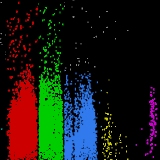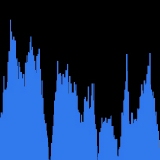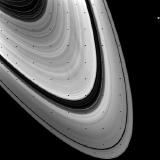 |
|||
|
European Southern Observatory image of the transneptunian
object 1994 TG2 - an asteroid, or a new class of object.
|
|||
| ASTEROID ORBITS | |||
| Asteroids are not spread randomly through the Solar System - they can be grouped into families based on their orbital characteristics. There is also a link between the chemical composition of an asteroid and its position in the Solar System. The geological nature of the asteroids varies as the distance from the Sun increases, even within the main asteroid belt between the orbits of Mars and Jupiter. | |||
| More about asteroid geology. | |||
| Main belt | |||
| Most asteroids orbit the Sun in what is called the main belt, a doughnut or torus-shaped zone between Mars and Jupiter, with orbits that lie 300 to 600 million kilometres from the Sun. | |||
 The asteroids tend to orbit in the main belt. |
|||
| They travel in the same direction as the Earth, and take between three to six years to make one journey around the Sun. Some groups of asteroids have very similar orbits. This suggests a parent asteroid that has been broken up by collision, and the remaining fragments share the orbit of the destroyed parent. The asteroids are grouped into families, depending on the orbital characteristics. The families, named after the main asteroid in the family, include Hungaria, Flora, Eos, Koronis, Themis, Phocaea, Cybeles and Hildas. | |||
 Asteroid families based on orbital parametres. |
|||
| Kirkwood Gaps | |||
| Jupiter's orbital period is about 12 years. If an asteroid has an orbital period of 6 years, it completes two orbits around the Sun for every one revolution made by Jupiter. The asteroid's orbit is in "resonance" with Jupiter's. Every 12 years, the asteroid is at its closest to Jupiter, and as a result extra gravitational force is applied to the asteroid on a regular basis. The asteroid's orbit is slowly altered, until it no longer has a resonant orbit. | |||
| Jupiter's effect is easily seen when the number of asteroids are counted and plotted against distance. There are gaps in the distribution that correspond to resonant periods. These gaps are known as Kirkwood Gaps, after Daniel Kirkwood, the American astronomer who discovered them. | |||
 Resonant orbits and Kirkwood Gaps. |
|||
| However, the gaps are gaps in the distribution of orbital periods, not real gaps in physical space. There are plenty of asteroids with eccentric orbits which move in and out of the gaps and keep them filled up. It can be confusing to have gaps in the distribution of asteroids, but not real gaps in the asteroid belt. Consider a crowded railway platform during a morning rush-hour. There are no gaps on the platform. There is, however, an age gap. There is a shortage of very young children and the elderly retired, as neither group are commuters. There is a gap in the age distribution, but no gap on the platform. In the asteroid belt, there are gaps in the orbital period and semi-major axis distribution, but no gaps in the belt. | |||
| A similar clearing of resonant orbits occurs in Saturn's ring system, where ring particles in resonance with a Saturnian moon are cleared out. However, as the ring particles do not have a wide range of orbital eccentricities, the gaps in orbital distribution are also real gaps in the rings. | |||
 Saturn's rings system. |
|||
| When an asteroid with a resonant orbit is perturbed by Jovian gravity, the result is the asteroid's perihelion moves closer to the Sun, and its aphelion moves further away. The combined effect is that the asteroid becomes planet-crossing. Jupiter puts asteroids on paths that lead to a planet capturing the asteroid, or to a planet being hit by the asteroid. | |||
| More about the Trojans | |||
| Trojans | |||
| There are some asteroids that are not located in the main belt, and neither do they have eccentric orbits that take them across the orbits of the planets. Rather, they are locked into a very stable orbit - an orbit they share with Jupiter. These are the Trojans, and they may have been trapped since the formation of the Solar System | |||
| Centaurs | |||
| Our knowledge of the location and characteristics of different types of asteroid is gradually improving. But increasingly, the distinction between comets and asteroids with different planet crossing orbits is not as clear as it once seemed. | |||
| Asteroids can also be found in the outer Solar System, with orbits that go beyond Saturn and Uranus. For example, the asteroid 5145 Pholus travels beyond Neptune, and 5335 Damocles swings from Mars to Uranus. Such asteroids are called "Centaurs", and have orbits that are unstable due to the gravitational forces of the planets. | |||
| Near-Earth Asteroids | |||
| In recent years the asteroids that have attracted the most attention are the 1% that leave the main belt and travel into the inner Solar System. As one of them may one day wipe out all life on Earth, their behaviour is viewed with concern. | |||
| More about Near Earth Asteroids | |||
|
|
|||